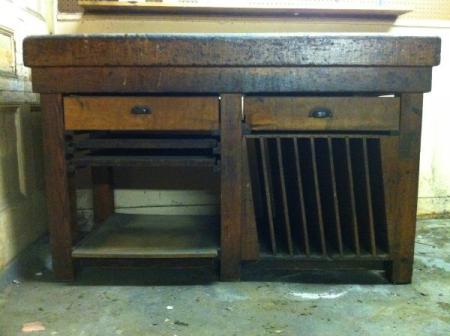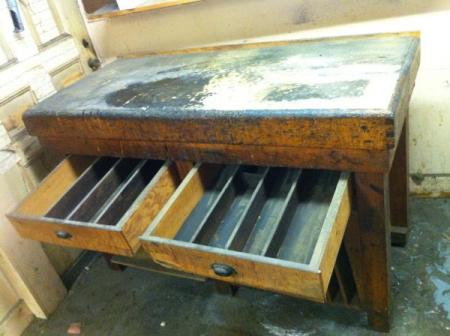Cleaning an imposing stone table?
Hello forum!
I recently acquired a great old press table with an inlaid imposing stone for next to nothing. It’s a bit beat up, but it’s solid, and with a little love I think it will be a great piece for my new press room.
However - this table sat next to an offset press and they used it to gum up their offset plates. I’ve got a heavy-duty steel scraper, but I was wondering if there was anything I could put on the gum to loosen it up and make it easier to scrape off. I also don’t want to damage the stone (If that’s possible? These things seem to take a licking…).
I’ve got odorless mineral spirits on hand (I use it as a press wash), would this work, or should I use something else? The man who sold it to me said the gum was anaerobic, I believe.
Appreciate any advice, thanks in advance!

letterpress_table.jpg

letterpress_table_top.jpg
if it is just gum i believe water should loosen it up. I use press wash on my stone then a very light coat of oil.
The stuff is called gum arabic, and yes, it’s water-soluble; in fact, it’s actually a gum arabic solution, mostly water, that’s used to gum offset plates (to prevent oxidation).
Great - thank you both!
If you want to clean it really well, warm water and a bit of mild soap should do the trick- couple drops of dawn dish soap to a quart of warm water.
Following this you could use any one of a variety of counter polishes designed for stone countertops to really provide it with a shine.
I agree with Dave and Dick.
I would keep the steel scraper away from it, unless you need it to very carefully and gently lift and remove a layer of gum arabic or other gunk, which you have already softened.
And by the way, it is an imposing stone.
http://dictionary.reference.com/browse/imposing+stone
my stone i use every day came from a old cabinet like the one you have, when we tried to move it the thing fell apart, under the stone built into the cabinet was a large tray that was full of wood type, you might want to check yours.
Proper terminology is ‘imposing stone’ or ‘imposing table’. The wood around the edge securing the stone is called ‘the coffin’. The printer whose job it was to set the type into position was called a ‘stone hand’. More than one printer has had a stone scavenged from a graveyard, which I find resourceful, but creepy. Some printers overlook the value of a good imposing surface, and an old pitted stone can be resurfaced and reset at a higher level using sawdust. Old stones are great as long as they can produce as the ultimate result - a perfectly flat printing surface.
Paul
Many or most stones were finished on both sides. When one side was dinged and scratched and beat up, the stone could be carefully removed and turned over. Folklore has it that the printer intended the second side to not be used as he intended that to be his tombstone. One printer was mad that his imposition man, or stone hand, had turned the stone months previously. He had intended it to be his tombstone.
I don’t know how dirty yours is, but I had one that was coated in a thick mess of dried black offset ink. I cleaned it with a kitchen sponge and some Gojo. It took forever, but in the end it cleaned up pretty well. I did a spot test with a razor blade scraper and found that it was difficult not to scratch the stone so I abandoned that tool rather quickly.
Daniel Morris
The Arm Letterpress
Brooklyn, NY
I’d like to emphasize what Paul previously said about having a stone resurfaced and reset. Seldom have I seen a stone that wasn’t dinged up, and in my opinion rendered useless for it’s intended purpose. Most large cities have stone cutters who can regrind a precision surface on their computerized flat bed tables. Similar process is used for kitchen countertops. In the Phoenix area I’ve pd $100-$150 and the results were worth it. Keep in mind that stones are porous. No grinder wants to clog up their grinding stones on an ink filled stone so it needs to be brought to them clean as possible. Surface dings are less of an issue to the grinder than gum and ink. I suggest that you don’t order a highly polished mirror finish stone but ask the grinder to provide a lesser finish.
Not quite the same, but perhaps interesting:
I read somewhere that the Queensland Government printing office, some 50 years ago, realised that the lithographic stones from the office had been used to build a wall in a nearby garden, so retrieved them; stones cleaned, and good work produced to show how litho work had been done; site now a museum with historic items as well as printing. If litho stones can be restored, I would expect similar treatment to effectively restore letterpress imposing stones.
Alan.
When I lived in Nashville in the late 1970s, I happened to be walking by an old building that had been consumed by fire, noting that a fellow was feverishly loading what looked like hundreds of foundation stones into a truck. Upon closer examination I saw that they were lithographic stones with amazingly beautiful images on them. When I went to ask the fellow about them he waved me off, not wanting to talk. I’m sure that he knew what an incredible score he had found.
Paul
Post updated to correct proper terminology.
Thanks to everyone for the useful advice, the table cleaned up beautifully with just a little water, dish soap and razor blade. Appreciate the help!
How much would a table like this sell for?
Buyer’s offer. They’re heavy, hard to move, and I’d also wager not a sought after item outside the field.
I suggest pricing it at around 500.00 OBO, be ready to lower the price for the right bidder (IE- someone who can move it), and see who bites.
Saw an article / photo (long ago) where a pastry chef re-purposed a Hamilton table & stone. She used it in her antique kitchen to make candy, fudge, etc. Assume the stone would have to be ground down enough to remove any chemical residual unless she had a new stone inserted into what appeared to be the original coffin. The article never mentioned the tables’ original use.
Just in passing, put half-a-crown (coin) down on the stone
and you could call an emergency chapel meeting. And also if the overseer (foreman) saw six odd em quad spaces laying about on the stone after lunch he knew that gambling had been going on - a game called ‘nicks up’ much like dice.
and also if you saw odd numbers chalked on the stone is a sort of pattern you knew that the overseer had been reminding himself abut the arrangement of pages for a very unusual imposition, sides to middle and so forth. .